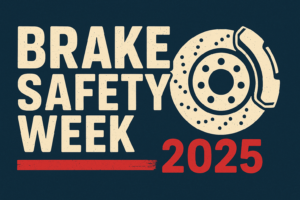Brake Safety Week, conducted by the Commercial Vehicle Safety Alliance (CVSA), is a major annual enforcement campaign across North America. This year, it is August 24-30, 2025. Thousands of roadside inspections are carried out with a targeted focus on brake system performance, which continues to be a top driver of out-of-service violations.
For Warehouse Distributors (WDs) and dealers, this is a unique opportunity to help fleets get inspection-ready — reducing the risk of violations, keeping trucks on the road, and promoting road safety. With the right strategies and products, WDs and dealers can go beyond sales to become essential partners in compliance and performance.
1. Educate Fleets on Inspection Criteria
One of the most effective ways to help fleets is to ensure they understand what inspectors are looking for. CVSA inspectors focus on key areas such as:
– Brake adjustment and pushrod stroke
– Brake lining/pad condition and wear
– Air leaks, warning systems, and reservoirs
– Hoses and tubing: condition, routing, and signs of chafing
– Friction surfaces like brake drums and rotors, looking for cracks, scoring, or contamination
– Calipers
Tip: Create or share a one-page visual guide summarizing key brake inspection points, including images of common violations.
2. Offer Brake Readiness Kits and Bundles
To help fleets prepare proactively, consider offering brake system bundles that make pre-inspection maintenance easy. These could include:
– Slack adjusters
– Brake chambers
– Air hoses, valves, and fittings
– Friction components such as pads, shoes, and — when needed — drums or rotors
– Calipers
Include inspection checklists with each package to promote a culture of preventative maintenance.
3. Support Preventive Maintenance Scheduling
Encourage fleets to perform brake checks and preventative maintenance early, before shops get overwhelmed or supply chains tighten. WDs and dealers can:
– Help schedule service or refer trusted partners
– Promote early replacement of worn-out linings or air system components
– Flag common wear points — such as hoses, adjusters, and occasionally drums or rotors nearing spec limits
Pro Tip: Offer “Brake Week Check” packages that cover the most common violation areas.
4. Stock Smart and Communicate Availability
As Brake Safety Week approaches, make sure your inventory includes the most commonly replaced brake components, such as:
– Valves, air lines, and slack adjusters
– Brake pads, shoes, and hardware kits
– Replacement brake drums and rotors
– Calipers
Keep customers informed through email, text, and social media about:
– What’s in stock
– What’s moving fast
– Specials or bundled savings
5. Offer Training for Drivers and Techs
Help your customers go into Brake Safety Week with confidence by offering quick, focused training:
– Pre-trip inspection best practices
– Common brake system red flags
– Hands-on brake system inspection demos
– A guide to identifying wear on linings, hoses, and friction surfaces
These sessions can be run in person, virtually, or even shared as short videos.
6. Promote Documentation and Inspection Readiness
Help fleets avoid surprises during roadside inspections by encouraging better recordkeeping and visual indicators:
– Offer pre-inspection forms or digital checklists
– Provide dated service labels for brake system work
– Suggest fleets document recent replacement of linings, hoses, and friction parts like rotors or drums
7. Provide Post-Inspection Support
After Brake Safety Week, check in with your customers:
– Did they experience any violations?
– Did any specific parts fail or get flagged?
– Can you help them correct issues for next time?
Use this feedback to fine-tune your inventory and service offerings for the year ahead.
Brake Safety Week is more than an enforcement event — it’s an opportunity for WDs and dealers to step in as trusted partners in safety and compliance.
By providing education, pre-inspection parts kits, service coordination, and responsive inventory, you can help fleets stay ahead of violations and minimize downtime. And while components like slack adjusters, chambers, and hoses are frequent culprits, don’t overlook the role of properly maintained brake drums and rotors — they’re critical to long-term braking performance.
With a little preparation and proactive support, your customers will be ready to roll confidently through Brake Safety Week — and beyond.


